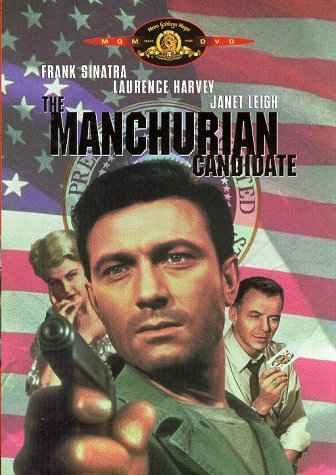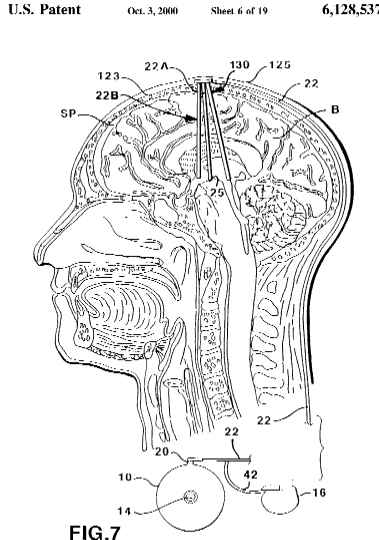|
Mind Control Most of human history has been a series of efforts by some humans to control what other humans think. When this effort doesn't take the form of a dominant organized Religion, we call it "mind control" and officially designate it as "bad."
Most of human history has been a series of efforts by some humans to control what other humans think. When this effort doesn't take the form of a dominant organized Religion, we call it "mind control" and officially designate it as "bad."
Cults and Secret Societies have used simple brainwashing techniques for as long as anyone can remember. The word "assassin," for instance, is Arabic for "user of hashish." The original assassins were an 11th Century Islamic cult of killers called the Nizari, who were promised the glories of martydom (not unlike their modern equivalents). Their leader offered a preview of the paradise to come, visions allegedly delivered via large doses of hash. In India, highly secretive cults flourished for centuries in the names of some of the more violent deities such as Kali. HypnotismIn addition to practicing simple mind control techniques on their own, these robber and murderer cults also inspired others to adopt their techniques. The Knights Templar were founded to fight off just such bands of robbers and murderers, who had been targeting Christian pilgrims in the Holy Lands.The Knights (and their brethren, the Freemasons) quickly discovered the power of cult techniques such as isolation, hypnagogic rituals, arcane initiations and oaths of secrecy, which they very successfully applied among their ranks. Despite being victimized by the skilled torturers of the Inquisition (themselves masters of "thought reform"), none of the loyal thousands of Knights ever spilled any of the group's deepest secrets. In the 1700s, Franz Anton Mesmer was born, marking a turning point in the history of mind control. Mesmer developed a technique called "animal magnetism" as a medical technique for treating a number of illnesses (primarily psychosomatic) which were not well understood at the time. Animal magnetism was quickly dubbed "mesmerism" and later morphed into "hypnotism." Mesmerism involved different techniques, including the placement or brandishment of literal magnets around the subjects, and the monotonous repetition of words and tones, which induced a trance-like state in its subjects.
Today, any respectable hypnotist will assure you that a person under hypnosis can't be induced to do anything they wouldn't normally be able to do. But then, it's not the respectable hypnotists that you have to worry about. Regardless of their protestations of harmlessness, the suggestibility of a hypnotized subject offers ample opportunity for the hypnotist to wreak havoc. Aside from the possibility of just ordering the subject to become a killing machine, which is not a reliable technique, one can plant suggestions that allow the subject to justify all manner of wrongdoing (i.e., "Jim is planning to kill you. He will kill you unless you kill him first. You had better kill him in self-defense."). Hypnotic techniques can also be used to plant "post-hypnotic" suggestions, in which a certain set of circumstances (such as the utterance of a "trigger phrase") cause the subject to act out a preprogrammed behavior. This is more popular as a Hollywood device than effective in the real world, but it can be done. The main problem with hypnosis as a mind-control technique is that it's pretty difficult to hypnotize someone against their will. That's why insidious megalomaniacs returned to the techniques used by the first Assassins drugs while inventing new and exciting ways to manipulate the masses in an economical fashion. Television and Subliminals[ambiguous: ad2.jpg] Subliminal mind control also plays to the suggestibility of humankind (i.e., the presumption that we are not much more sophisticated than sheep). The technique, most famously used in advertising, involves embedding secret images into harmless-looking images in order to "sneak" a message directly into the viewers subconscious.Subliminal advertising has existed for a long time in the form of subtle visual cues embedded in still pictures, but the technique first hit the big time in the 1950s, when marketer named James Vicary invented a method for inserting subliminal messages into films. His technique would flash a simple text message for a single frame on a movie screen. While viewers were enjoying a nice movie, the words "Eat popcorn" or "Drink Coke" would flit by on the screen too quickly for the conscious mind to see. The results were anecdotally reported to be spectacular, with massive increases in theater concessions sales. The apparent success of the technique (which was never replicated in a controlled scientific setting) alarmed the hell out of most people and subliminal advertising was subsequently banned (although it still pops up in insidious ways, especially in liquor ads for some reason). The use of subliminals in mind control of the "Big Brother-evil empire" variety has never been extensively documented (unlike the use of drugs, see below), but it stands to reason that if the technique is even marginally effective, someone is probably using it. Subliminals and hypnotism have also been adopted by the "self-help" crowd, as a way to assist people in difficult tasks which they would prefer not to accomplish through self-discipline and hard work. These include, most prominently, quitting smoking and losing weight. Retailers everywhere stock endless recordings of happy white-sound noises (such as ocean surf or New Age ambient music) which feature subliminal audio tracks running underneath, with messages such as "You don't want to smoke" or "You don't want to eat." While scientific types are highly skeptical about the effectiveness of subliminals, science hardly matters to people who want to make a quick buck, or people who want to quit smoking without tears. Behavioral ConditioningGeorge Orwell presented one of the most thorough visions of a behaviorally controlled society in "1984," a nightmare vision of a world in which government uses heavy-handed techniques to keep people thinking the right kinds of thoughts at any given time. Sci-fi writer Philip K Dick also frequently delved into this territory, as did Patrick McGoohan's groundbreaking TV series, "The Prisoner." In addition to such obvious techniques as torture and drugs, behavioral conditioning can be accomplished in more subtle ways, often reputedly employed by religious cults and top secret government prisons. Known as "coercive persuasion," the technique involves breaking up an individual's usual routine, isolating them from contact with the outside world, Pavolovian rewards and punishment, and "non-violent" coercions such as sleep deprivation, humiliation and various kinds of noise disruptions. Although religious cults took a lot of heat in the 1980s and 1990s for employing these techniques, that hasn't stopped the George W Bush Administration from openly and shamelessly using these methods against alleged terrorists such as Jose Padilla and Khalid Shaikh Mohammed, despite prohibitions against such treatment of prisoners in the Geneva Conventions. The rationale offered by the administration for these actions pretty much boils down to "The end justifies the means." But then, Bush is hardly the first U.S. president to oversee mind control projects. He's just the first to bother offering a rationale. Which brings us, inevitably, to the subject of... Drugs! Although Ben Franklin is rumored to have investigated hypnotism on behalf of the government back in the early days of the nation, the institutionalization of mind control techniques by top-secret government conspiracies didn't become a growth industry until the onset of the Cold War.
Although Ben Franklin is rumored to have investigated hypnotism on behalf of the government back in the early days of the nation, the institutionalization of mind control techniques by top-secret government conspiracies didn't become a growth industry until the onset of the Cold War.
Inspired in part by Nazi successes with propaganda and torture techniques, the Central Intelligence Agency and the KGB undertook massive research ventures designed to break human beings down into malleable robots, which was considered a useful technique in both intelligence practices and domestic governance. In the 1950s, the CIA began experimenting with mind-control as part of an infamous program known as MKULTRA. The most famous outgrowth of this program was the popularization of LSD as a recreational drug, which had rather the opposite effect on society than was being sought. Under MKULTRA, the CIA conducted hundreds of experiments on unwitting people in the San Francisco area and elsewhere. In some of these tests, the Agency hired hookers to dose their johns with LSD so CIA scientists could study the effects. The agency shredded most of its documentation on the MKULTRA plan before it became public. What little is known suggest that the government was trying to create "supersoldiers" and sleeper agents who would feel no pain and who would be under the absolute control of their superiors. The Soviets were engaged in similar experiments, which formed the basis of the movie "The Manchurian Candidate," in which Frank Sinatra played a mind-controlled former prisoner of war sent on a mission of assassination against the U.S. A side-effect of these proven experiements is a whole host of unproven conspiracy theories regarding mind control and political assassinations. Virtually every major political assassination in the 20th Century has been attached to a mind-control conspiracy of lesser or greater credibility, including John F. Kennedy, Robert F. Kennedy, Martin Luther King and Malcolm X. The Robert Kennedy case is particularly interesting to mind control aficionados. RFK was killed by a "lone gunman" named Sirhan Sirhan. According to Sirhan's defense team, the assassin was extremely susceptible to hypnosis. When a defense psychologist hypnotized him, the first thing Sirhan allegedly said was, "I don't know any people." Sirhan appeared to be in an altered state of consciousness when he was arrested and claimed to have no memory of shooting RFK. Regardless of all these claims, one thing is pretty clear: LSD is remarkably ineffective as a mind control agent. Barbiturates and narcotics are useful for encouraging trance states, but they also diffuse the subject's focus, making hypnotism per se problematic. Highly addictive drugs are often used as the "poor man's mind control," by hooking the subject on coke or heroin and then making them do tricks to get their fix. This technique (most commonly used to obtain blow jobs) is notoriously unreliable, since hardcore addicts tend to be pretty unstable. Relatively new drugs such as Ritalin and Prozac have been the subject of much speculation among conspiracy theorists, since they have a remarkable success rate in transforming rebellious or difficult children (and adults) into compliant conformist consumers without the need for such tedious old-school techniques as "parenting" and "discipline."
The current "thinking" is that 5 percent of U.S. children are suffering from this "disease," for which the NIMH lists such symptoms as inattentiveness in school, the inability to sit still, the desire to run around and play, fidgeting in a classroom chair, impulsiveness and impatience, or making inappropriate comments. If you remember doing any of these things as a child, then you really missed out on the super drug-induced behavior modification that kids today enjoy so well. Upwards of 8 million American children are estimated to be using Ritalin or a related drug type, and that appears to be a lowball estimate based on old data. Ritalin use has increased nearly 1,000 percent in 10 years. If all that isn't "Big Brother" enough for you, consider this tidbit from NIMH: "Physicians and parents should be aware that schools are federally mandated to perform an appropriate evaluation if a child is suspected of having a disability that impairs academic functioning (specifically including ADHD)." So don't worry! If you can't keep your kid in line, The Man will do it for you! Sci-Fi Techniques With all this ugly reality out there, you wouldn't think there would be a great need for nutty conspiracy theories about cornball sci-fi mind control techniques being secretly employed against the masses. But you'd be wrong.
With all this ugly reality out there, you wouldn't think there would be a great need for nutty conspiracy theories about cornball sci-fi mind control techniques being secretly employed against the masses. But you'd be wrong.
One of the favorite modern theories about secret mind control has to do with satellites beaming microwaves or other forms of virulent radiation into the brains of a mostly unsuspecting public (as in the HAARP Project, among others). The suspecting public appears to be largely composed of schizophrenics, who for some reason are particularly fond of this theory. Hell, maybe it's true, who knows? There is no publicly available scientific research to support the idea that microwaves can be used for mind control, but then there wouldn't be, now would there? Magnetism has also been a favored sci-fi approach to mind control since the days of Mesmer's animal variety. There's a sort of, kind of, general plausibility to this thinking that stems from the electrical nature of the brain, but again, you'd be hard pressed to find a working theory to explain how one goes from the general idea to a working prototype. The lack of credible research is no obstacle to the determined inventor, however, as evidenced by the dozens of patents on file for various gadgets and gizmos intended to transform the Average Joe into an Empowered-Mind-Dominating-Superfreak. One such device is an "apparatus for and method of sensing brain waves at a position remote from a subject (... which) also can be used to produce a compensating signal which is transmitted back to the brain to effect a desired change in electrical activity therein." This 1976 patent apparently never made it to mass production (or if it did, all memory of such a device has been eradicated from our brains using the device itself). Not all approaches to mechanical mind control are so subtle. Since electroshock therapy came on the scene in the 1940s, numerous methods have been introduced to "help" people with behavioral conditioning, usually via electrical shock. The most innocuous of these involves a wristband designed to shock smokers when they lift a cigarette to their lips. Among the most lethal-looking is a device that appears to involve electrically charged spikes driven into one's skull. Now, THAT'S a good time!
|
 In a hypnotic trance, the subject is prone to suggestibility. They tend to believe what they are told and their senses will malfunction to back up these suggestions. Mesmer primarily used the technique to cure various stress-related illnesses but it soon became clear that hypnotism could also be used to make people do things they wouldn't normally do.
In a hypnotic trance, the subject is prone to suggestibility. They tend to believe what they are told and their senses will malfunction to back up these suggestions. Mesmer primarily used the technique to cure various stress-related illnesses but it soon became clear that hypnotism could also be used to make people do things they wouldn't normally do.
 Ritalin is a central nervous system stimulant designed to treat a "disease" called "attention deficit hyperactivity disorder." Now, you may be wondering why a stimulant is used to treat hyperactivity, but you're not a doctor, so give up any hope of understanding. You're just going to have to trust The Man. (Even doctors don't have a good answer to this question. The National Institute of Mental Heatlh says "The answer to this question is not well established," and adds "more research is needed." Implied but not overtly stated are the credos: "Trust The Man" and "We Just Pump Your Kids Full Of Drugs Until Something Seems To Work.")
Ritalin is a central nervous system stimulant designed to treat a "disease" called "attention deficit hyperactivity disorder." Now, you may be wondering why a stimulant is used to treat hyperactivity, but you're not a doctor, so give up any hope of understanding. You're just going to have to trust The Man. (Even doctors don't have a good answer to this question. The National Institute of Mental Heatlh says "The answer to this question is not well established," and adds "more research is needed." Implied but not overtly stated are the credos: "Trust The Man" and "We Just Pump Your Kids Full Of Drugs Until Something Seems To Work.")